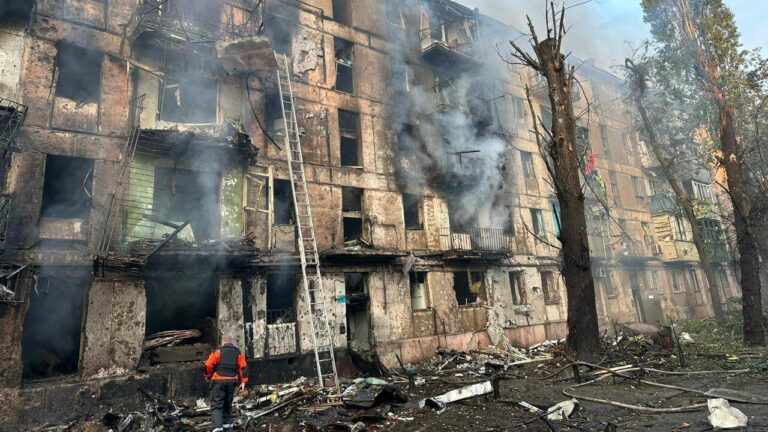Ukraine has announced a significant counterstrike, claiming to have hit a Russian airbase in response to a recent wave of drone attacks launched by Russia. The developments mark a sharp escalation in the ongoing conflict between the two countries, as both sides continue to exchange strikes amid mounting tensions. This latest exchange underscores the intensifying nature of the war and raises concerns about further military confrontations in the region.
Ukraine Claims Successful Strike on Russian Airbase Amid Escalating Drone Attacks
Ukrainian forces reportedly carried out a precise airstrike targeting a key Russian airbase, intensifying the ongoing conflict that has seen an increase in drone activity on both sides. According to Ukrainian officials, the strike inflicted significant damage on the base’s infrastructure and military assets, disrupting Russian operational capabilities in the region. This latest development comes as Russia escalates its use of unmanned aerial vehicles (UAVs) to launch repeated attacks on Ukrainian territories, aiming to weaken defensive positions and supply lines.
The surge in drone offensives has prompted Ukrainian forces to enhance their air defense systems, leading to a dynamic battlefield marked by rapid countermeasures and electronic warfare. Some key points about the recent engagements include:
- Location targeted: Russian airbase in western Russia, crucial for aerial operations
- Impact: Damage to hangars, fuel depots, and command centers
- Russian response: Increased drone deployments aiming to regain air superiority
| Aspect | Ukrainian Activity | Russian Activity |
|---|---|---|
| Drone Usage | Enhanced airstrikes on key military sites | Increased UAV raids on civilian and military targets |
| Air Defense | Upgraded anti-drone systems | Deployment of countermeasures to disrupt defenses |
| Operational Focus | Targeting logistics and command hubs | Attempts to degrade Ukrainian infrastructure |
Assessing the Strategic Impact of Cross-Border Operations on the Russia-Ukraine Conflict
The recent Ukrainian strike on a Russian airbase exemplifies the increasing complexity and strategic depth of cross-border operations within the ongoing conflict. These strikes serve not only as tactical blows against Russian military infrastructure but also as a psychological tool aimed at undermining Russian operational confidence. Moscow’s deployment of drones into Ukrainian territory underscores a shift towards leveraging asymmetric aerial assets in contested environments, intensifying both surveillance and offensive capabilities. Such moves reflect a broader trend where each side attempts to exploit vulnerabilities beyond conventional frontlines, reshaping the operational landscape in unpredictable ways.
Key strategic impacts observed include:
- Disruption of Logistics: Targeting airbases impairs Russia’s ability to maintain steady air support and supply lines critical for frontline units.
- Escalation Risks: Cross-border strikes elevate the conflict’s intensity, raising concerns of potential spillover into neighboring areas.
- Technological Adaptation: Increased drone deployments suggest a pivot towards unmanned systems for reconnaissance and strikes, signaling a new phase in warfare dynamics.
| Operation | Objective | Impact |
|---|---|---|
| Ukrainian Airbase Strike | Disable Russian air assets | Reduced air support capability |
| Russian Drone Incursion | Gather intelligence and conduct strikes | Heightened threat perception |
| Cross-Border Artillery Fire | Pressure frontline positions | Increased frontline instability |
Recommendations for Strengthening Air Defense Systems Against Increasing Drone Threats
Given the escalating use of drones in modern conflicts, enhancing air defense capabilities has become critical for national security. Integrating multi-layered detection systems that combine radar, infrared sensors, and acoustic technologies can substantially improve early warning and tracking accuracy. This hybrid approach allows forces to distinguish between hostile drones and civilian UAVs, ensuring timely responses while minimizing false alarms. In addition, developing AI-driven threat assessment algorithms can accelerate decision-making processes by automating drone classification and prioritizing targets based on behavioral patterns and payload capacity.
Moreover, strengthening counter-drone measures through a blend of kinetic and non-kinetic options offers a flexible and effective defense posture. This includes deploying electronic warfare units capable of jamming or hijacking drone control signals, complemented by precision-directed energy weapons and interceptor drones designed to neutralize incoming threats. The following table summarizes key technological strategies for bolstering air defense systems against the growing drone menace:
| Strategy | Description | Benefit |
|---|---|---|
| Multi-Sensor Integration | Combines radar, IR, and acoustic sensors | Improves detection accuracy |
| AI-Powered Threat Analysis | Automates drone identification and risk prioritization | Speeds up response time |
| Electronic Warfare | Disrupts drone communications and navigation | Neutralizes threats without collateral damage |
| Kinetic Interceptors | Deploys missiles or drones to destroy enemy UAVs | Provides decisive physical elimination |
Key Takeaways
As tensions continue to escalate in the ongoing conflict, Ukraine’s reported strike on a Russian airbase marks a significant development amid increasing drone incursions into Ukrainian territory. Both sides appear to be intensifying their military actions, underscoring the fragile and volatile nature of the situation. Observers will be closely watching how these exchanges influence the broader dynamics of the conflict moving forward.




